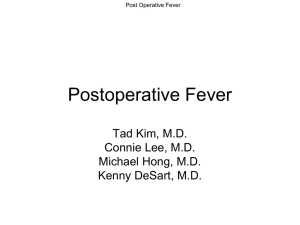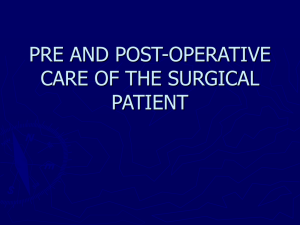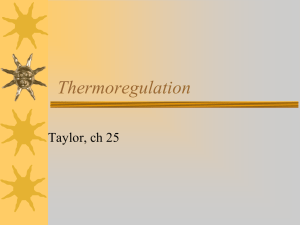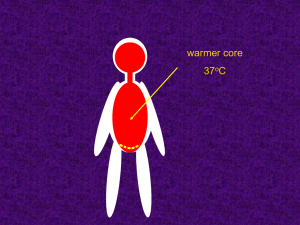Postoperative Fever
advertisement
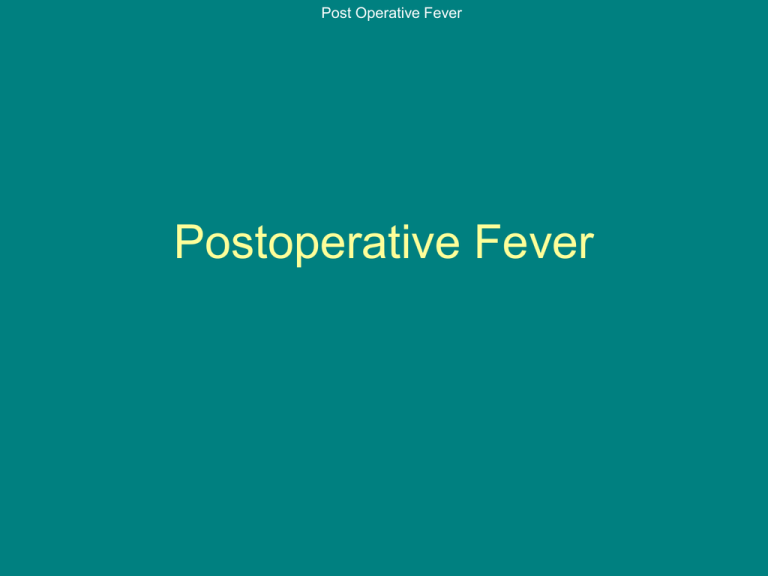
Post Operative Fever Postoperative Fever Post Operative Fever Pathophysiology • Fever >38ºC is common after surgery • Usually inflammatory stimulus of surgery and resolves spontaneously • Fever = response to cytokine release – Fever-associated cytokines are released by tissue trauma and do not necessarily signal infection – Cytokines produced by monocyte, macrophages, endothelial cells – Fever-associated cytokines = IL-1, IL-6, TNF-alpha, IFN-gamma Post Operative Fever DDX: The 5 W’s 1. 2. 3. 4. 5. Wind (POD#0) Water (POD#3) Wound (POD#5) Walking Wonder-drug Atelectasis, pneumonia UTI, anastomotic leak Wound infection, abscess DVT / PE Post Operative Fever DDX: Immediate Fever • Immediate fever: onset in OR or in the immediate postoperative period • DDX: – Medication reactions: antibiotics, blood products, malignant hyperthermia. Often p/w hypotension. – Necrotizing infection: Clostridium, Group A β-hemo strep. Treatment: ABC, resuscitate, ABX: pip/tazo and clindamycin, surgical debridement Post Operative Fever DDX: Acute Fever • Acute fever: first week after surgery • DDX: – necrotizing infection (within 48hrs) – anastomotic leak (classically POD# 3 to 5) – Pulmonary embolism – MI – Pneumonia – Aspiration – UTI – Surgical site infection (SSI) – ETOH withdrawal – Other: acute gout, pancreatitis Post Operative Fever DDX: Subacute • Subacute fever: >1 week after surgery • DDX: – Surgical site infection – UTI – Line infection – Antibiotic-associated diarrhea – Febrile drug reactions – Thrombophlebitis – Sinusitis Post Operative Fever Evaluation • ABCs • Resuscitate • HPI: anesthesia record, operative note, nursing report, flowchart • PE: – Complete exam – Look at wounds - take off dressings – Look at drain output – Check PIV sites, CVL, Foley, tubes Post Operative Fever Labs/Studies • Labs to order if concerned for infection: – CBC w diff, sputum Cx, UCx, Blood Cx x2 – C. diff toxin assay • Imaging: – CXR (for pneumonia) – Lower extremity venous duplex (for DVT) – CT scan (for abscess, leak, pancreatitis, PE) Post Operative Fever Management • Intervention needed? • Remove/replace sources of infection – Foley catheter, central lines, or peripheral IV’s – Open, debride, and drain infected wounds • If suspect pneumonia, bacteremia, UTI, sepsis – start broad spectrum antibiotics • Anticoagulation for DVT/PE • CT guided drainage of abscess Post Operative Fever Case 1 • 58y M 5hrs after B/L total knee arthroplasty. Temp 38.7 C. Pain adequately controlled w/meds. No antibiotics. • PE: HR 90, BP 130/70, O2 sat: 99% – Mild serosanguinous drainage from knees – No Foley or CVL – WBC 7 • What is your plan? Post Operative Fever Case 1 • What is your plan? – A. Urine culture – B. Blood, urine cultures & CXR – C. Blood, urine cultures & vancomycin – D. Observation only Post Operative Fever Case 2 • 65y F w/ obesity, DM now 5hrs s/p open cholecystectomy for gangrenous cholecystitis c/o abdominal pain. Temp 40C, tachycardia. • VW: HR 140, BP 88/50, O2 Sat 94% • PE: AMS, wound is blistered, +crepitus, w/ dirty dishwater drainage • What is your diagnosis? • What is your plan? Post Operative Fever Case 2 • • What is your diagnosis? A. Cellulitis B. Diffuse peritonitis This patient is in septic shock C. Necrotizing fasciitis D. Uncomplicated post operative fever What is your plan? A. Observe B. ABC, resuscitate, IV antibiotics C. ABC, resuscitate, IV antibiotics, immediate surgical debridement Post Operative Fever Case 3 • 61y F w rheumatoid arthritis on methotrexate undergoes left total hip replacement. Foley catheter present postoperatively. POD#3 temp 38.1C, Foley is removed. POD#4 temp 38.5 C. • She has been ambulating and using incentive spirometry • PE: O2 Sats and vitals are normal, wound is clean Post Operative Fever Case 3 • What is the most likely diagnosis? – A. Deep venous thrombosis – B. Urinary tract infection – C. Superficial wound infection – D. Prosthesis infection • UTI evaluation: history, U/A, urine culture • Evaluate for other possibilities Post Operative Fever Take Home Points • The 5 W’s • Think the worst and rule it out! • Necrotizing fasciitis must be identified and treated aggressively

